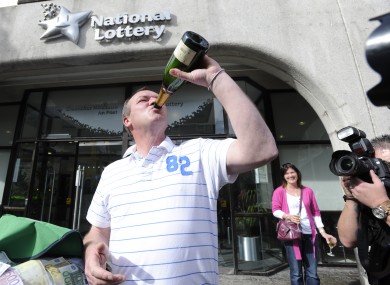Rising Irish market demand sees Nama prepare to sell €300 worth of property loans


NAMA is preparing to sell about €300m of property loans as demand from overseas buyers rises, three people with knowledge of the plan said.
The loans are linked to properties built by Dublin-based developer McGarrell Reilly Group and will be sold at a discount, according to the people, who declined to be identified because the matter is private.
Ray Gordon, a Nama spokesman who works for public relations firm Gordon MRM, and Sean Reilly, executive chairman of McGarrell Reilly, declined to comment.
International investors have been buying property and loans backing real estate in Dublin as returns rebound following Ireland’s property crash.
Overseas investors bought about 70% of the €545m of income-producing property sold in Ireland last year, compared with little or none in 2007, according to CBRE Group.
McGarrell Reilly’s developments include The Watermarque office building near Google’s European headquarters and the Iveagh Court office complex in Dublin’s central business district, according to its website.
The Irish Independent reported in May that Reilly was trying to buy back the loans at a discount from Nama without saying where it got the information.
Nama was set up in 2009 by the government to take over €74bn of risky commercial real estate loans held by Ireland’s banks and sell them over as many as 10 years.
Ireland’s teenage births at lowest level in 12 years while suicides at all-time high
The percentage of babies born to teenage mothers is at a 12-year low, but the number of suicides is at its highest level since records began.
New figures from the Central Statistics Office (CSO) on births and deaths in 2011 paint a mixed picture of Irish life. They show that:
* After a decade-long baby boom, the birth rate is falling and is now at its lowest level since 2009, with 74,033 babies born in 2011, yet Ireland continues to have the highest fertility rate in the EU.
* The number of teenage pregnancies has fallen again. Some 2.3pc of all births (1,690 babies) were to women under the age of 20, down from a high of 6.2pc in 1999.
* The number of babies born outside of marriage continues to grow, with 25,091 babies or 33.9pc of all births in 2011 falling into this category, up 0.1pc compared with 2010.
* The recession has seen a huge increase in the number of suicides. In 2011, 554 people took their lives, up from 458 in 2007. Suicides are believed to be at their highest level since records began in 1890.
* Heart and vascular diseases were the leading causes of death in 2011, closely followed by cancer, with each accounting for almost a third of the total number of 28,456 deaths.
The CSO’s Vital Statistics 2011 report released yesterday shows Ireland’s baby boom appears to be on the wane, with a fall in the number of births for the second successive year. In 2011, 74,033 children were born – 37,898 boys and 36,135 girls – down 1.5pc on 2010.
The fertility rate – how many children an Irish woman has in her lifetime – fell in 2011 from an average of 2.06 to 2.02. However, Ireland still has the highest fertility rate in the EU, despite it falling by 34pc since 1981.
The average age of women giving birth in 2011 was 31.8 years, but the figures show the number of teenage mothers continues to fall and is now at a 12-year low. Most of these births were to mothers aged 18 and 19; 103 were to girls aged 16; and 36 babies were born to girls aged 15 and under.
Just over a third of babies (33.9pc) born in 2011 were born outside of marriage or civil partnership, but the highest level was seen in Limerick city, where 48.8pc of all babies were born to unwed parents, while the lowest was in Co Galway, at 25.2pc.
The busiest day for deliveries in 2011 was September 29 when 269 were born around the country, while the quietest was May 8 when only 113 were born.
While almost all babies are born in hospital, there was a slight increase in the number of home births (334), up 2.5pc on 2010.
The report shows a worrying increase in the number of suicides, with 458 men and 96 women taking their lives in 2011. This is more than twice the number of suicides of 30 years ago, and accounted for almost 2pc of all deaths in 2011.
TURMOIL
The biggest number of suicides was in Co Cork (62), followed by Dublin city (57), south Dublin (37) and Wexford (29). Those aged between 25 and 34 were most likely to take their lives.
Ciaran Austin of Console said the record high number of suicides was “very concerning”.
He said that while it was impossible to draw a direct correlation between the recession and the number of suicides, it reflects a global trend during times of economic turmoil.
“Economic issues, debts, unemployment can put additional strain on people and will add extra stress to those who are already vulnerable.”
He criticised the time-lag in recording suicides, which often does not happen for several years, and called for improved recording of suicides so that resources can be targeted at specific counties quickly.
Irish Doctors strike action will go ahead on next Tuesday


The Irish Medical Organisation says it is resigned to the Junior Doctors strike action plan is going ahead next Tuesday.
The IMO was responding to comments from the HSE today, suggesting the strike was avoidable.
The HSE wants doctors to return to the Labour Relations Commission to discuss a resolution of the dispute, which centres around working hours.
But the union says talks won’t produce results as the two sides are still divided on a number of serious issues.
Eric Young of the IMO said “we have had many talks … but unfortunately the situation is now that we have to do something.”
He said one major issue outstanding was the implementation of sanctions on hospitals which don’t adhere to deadlines for reducing hours.
Irish Lottery state asset sale raises €405 million


For once the sale of a State asset, the National Lottery, has been completed without either public controversy or political recrimination about sale of the family silver.
The deal that the Government has struck with Premier Lotteries Ireland – which includes An Post and Camelot, a UK lottery operator – for the sale of the lottery license is a good one. The sale should leave most people satisfied: first, with the price obtained; second, with the terms agreed with the new operator; and third with how the Government plans to use the sale proceeds.
By selling the national lottery licence for €405 million, the Government has secured a sale price that is one third higher than initial industry estimates for the franchise. The terms of sale include a continuing State involvement, via An Post’s role. And, few will criticise how the Government proposes to spend the privatisation proceeds. For half the sum raised will be spent on financing the construction of the long awaited National Children’s Hospital in Dublin, with the first of two payments to the exchequer scheduled before year end, and the second next year. As the Government struggles to meet annual budget targets, and plans to leave the international bailout programme by year-end, the sale proceeds could not come at a more opportune moment.
Since its introduction in 1987, the National Lottery has proved highly popular with the public, and very beneficial for the charities, sporting bodies and worthy causes that have received lottery funding – over €4 billion in the past 26 years. Ireland, on a per head basis, spends more on lottery tickets than most other European countries. And while six years of austerity measures have depressed ticket sales somewhat during the recession, nevertheless the lottery has managed to retain its broad appeal to the public.
Recent changes made under the Lottery Act are seen as central to the growth of the National Lottery, and the income that it can generate for good causes. At present, just three per cent of its revenue comes from online sales, compared with 15 to 17 per cent in Camelot’s UK operation. The easing of legal restrictions on the online sale of lottery tickets has greatly enhanced the lottery’s potential for revenue growth. And the Government is confident that under the new licensing terms for the lottery the annual income for good causes, at present €225 million, can be raised to €300 million in five years.
The sale of the National Lottery marks the first in a series of disposals of State-owned assets – some €3 billion – designed in part to pay down public debt and, as in the case of the proposed sale of Bord Gais Energy, in part to finance a stimulus fund to boost jobs. The Government’s skilled handling of the sale of the National Lottery, hopefully, augurs well for successful completion of the rest of the privatisation programme.
Why are there still so few Women in Science?
Researchers at Yale University published a study proving that physicists, chemists and biologists are likely to view a young male scientist more favorably than a woman with the same qualifications. Presented with identical summaries of the accomplishments of two imaginary applicants, professors at six major research institutions were significantly more willing to offer the man a job. If they did hire the woman, they set her salary, on average, nearly $4,000 lower than the man’s. Surprisingly, female scientists were as biased as their male counterparts.
The new study goes a long way toward providing hard evidence of a continuing bias against women in the sciences. Only one-fifth of physics Ph.D.’s in this country are awarded to women, and only about half of those women are American; of all the physics professors in the United States, only 14 percent are women. The numbers of black and Hispanic scientists are even lower; in a typical year, 13 African-Americans and 20 Latinos of either sex receive Ph.D.’s in physics.
The reasons for those shortages are hardly mysterious — many minority students attend secondary schools that leave them too far behind to catch up in science, and the effects of prejudice at every stage of their education are well documented. But what could still be keeping women out of the STEM fields (“STEM” being the current shorthand for “science, technology, engineering and mathematics”), which offer so much in the way of job prospects, prestige, intellectual stimulation and income?
As one of the first two women to earn a bachelor of science degree in physics from Yale — I graduated in 1978 — thisquestion concerns me deeply. I attended a rural public school whose few accelerated courses in physics and calculus I wasn’t allowed to take because, as my principal put it, “girls never go on in science and math.” Angry and bored, I began reading about space and time and teaching myself calculus from a book. When I arrived at Yale, I was woefully unprepared.
The boys in my introductory physics class, who had taken far more rigorous math and science classes in high school, yawned as our professor sped through the material, while I grew panicked at how little I understood. The only woman in the room, I debated whether to raise my hand and expose myself to ridicule, thereby losing track of the lecture and falling further behind.
In the end, I graduated summa cum laude, Phi Beta Kappa, with honors in the major, having excelled in the department’s three-term sequence in quantum mechanics and a graduate course in gravitational physics, all while teaching myself to program Yale’s mainframe computer. But I didn’t go into physics as a career. At the end of four years, I was exhausted by all the lonely hours I spent catching up to my classmates, hiding my insecurities, struggling to do my problem sets while the boys worked in teams to finish theirs. I was tired of dressing one way to be taken seriously as a scientist while dressing another to feel feminine. And while some of the men I wanted to date weren’t put off by my major, many of them were.
Mostly, though, I didn’t go on in physics because not a single professor — not even the adviser who supervised my senior thesis — encouraged me to go to graduate school. Certain this meant I wasn’t talented enough to succeed in physics, I left the rough draft of my senior thesis outside my adviser’s door and slunk away in shame. Pained by the dream I had failed to achieve, I locked my textbooks, lab reports and problem sets in my father’s army footlocker and turned my back on physics and math forever.
Not until 2005, when Lawrence Summers, then president of Harvard, wondered aloud at a lunchtime talk why more women don’t end up holding tenured positions in the hard sciences, did I feel compelled to reopen that footlocker. I have known Summers since my teens, when he judged my high-school debate team, and he has always struck me as an admirer of smart women.
When Lawrence suggested — among several other pertinent reasons — that innate disparities in scientific and mathematical aptitude at the very highest end of the spectrum might account for the paucity of tenured female faculty, I got the sense that he had asked the question because he genuinely cared about the answer. I was taken aback by his suggestion that the problem might have something to do with biological inequalities between the sexes, but as I read the heated responses to his comments, I realized that even I was not sure why so many women were still giving up on physics and math before completing advanced degrees.
I decided to look up my former classmates and professors, review the research on women’s performance in STEM fields and return to Yale to see what, if anything, had changed since I studied there. I wanted to understand why I had walked away from my dream, and why so many other women still walk away from theirs.




No comments:
Post a Comment